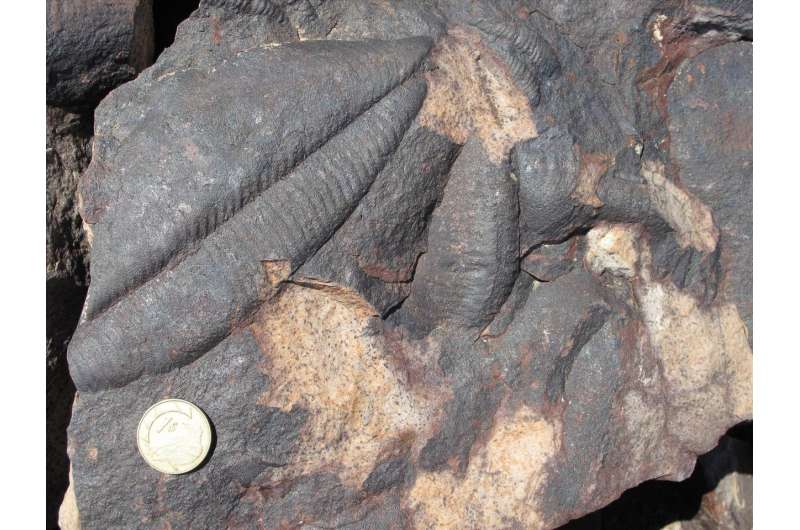
If so, it “has just gone nuclear,” he writes. Gone nuclear? Funny how life has a way of imitating comedy. Weren’t some of us wasting our time recently trying to create a panic about radioactive snowflakes in outer space? And while we weren’t looking, the Cambrian Explosion …
Okay, the story is that Bechly has been making the point that Cambrian life form Dickinsonia is “unlikely to be an animal.”* Someone over at Peaceful Science took issue with that.
While mulling the matter, Bechly went back to the publications and stumbled across something quite remarkable:
Recently, I stumbled upon a paper from 2018 that I had previously overlooked, and it proved to be dynamite. It is a study by a research group from the University of Zurich about the transition from the Ediacaran organisms to the Cambrian animal phyla in the Nama Basin of Namibia (Linnemann et al. 2018). What they found is truly mind-blowing. The window of time between the latest appearance date (LAD) of the alien Ediacaran biota and the first appearance date (FAD) of the complex Cambrian biota was only 410,000 years. You read that correctly, just 410 thousand years! This is not an educated guess but based on very precise radiometric U-Pb dating with an error margin of only plus-minus 200 thousand years. This precision is truly a remarkable achievement of modern science considering that we are talking about events 538 million years ago.
The authors of the study fully realized that their finding documents an unexpected “extremely short duration of the faunal transition from Ediacaran to Cambrian biota.” Therefore, they speculated about ecologically driven reasons for this rapid onset of the Cambrian Explosion.
Günter Bechly, “The Cambrian Explosion Has Just Gone Nuclear” at Evolution News and Science Today (April 8, 2021)
Nope. Ecology won’t do that for us. The process isn’t just somehow happening. Something is driving it.
Here’s the original media release from 2018:
Using uranium-lead dating, Senckenberg scientists, in cooperation with an international team, were able to date the onset of the “Cambrian explosion” to precisely 538.8 million years ago. During the “Cambrian explosion,” all currently known “blueprints” in the animal kingdom appeared within a few million years, while at the same time the so-called “Ediacara biota” – a group of unique, specialized life forms – became extinct. The study was recently published in the scientific journal Terra Nova…
Moreover, the scientists’ data series reveal that the development of the fauna took place within a very short period. The transition from the “Ediacara biota” – multi-celled but very simply organisms – to the diverse Cambrian life forms occurred over less than 410,000 years. “From a geological point of view, this represents a veritable sprint,” according to the research team. Based on the current study, this rapid faunal change may be best explained as a kind of “biological arms race”: New fundamental traits accelerated the subsequent evolution and fueled the next “adaptive breakthrough.” “For example, if an organisms became increasingly mobile and fed on prey, previously even less mobile animals had to come up with new ways to protect themselves – which may have led to the rapid development of shells or skeletons. One achievement thus engendered the next – and, by necessity, within a shortened period of time,” says Linnemann in summary.
Senckenberg Research Institute and Natural History Museum, “Uranium-lead dating shows that the Cambrian explosion is younger than previously thought” at Phys.org (December 19, 2018)
This is the usual Darwinian short circuit. The fact that a life form would be better off with, say, eyes does not mean it will just start to develop them any more than the fact that a woman might be better off without a chronic illness means she can just get over it. The solutions to some problems requires focused intelligence.
Bechly adds,
The Cambrian Explosion has gone nuclear and simply evaporates neo-Darwinism as a brilliant and beautiful but failed scientific theory, as it was recently called by Yale University professor David Gelernter (2019).
Günter Bechly, “The Cambrian Explosion Has Just Gone Nuclear” at Evolution News and Science Today (April 8, 2021)
No wonder the paper, which is closed access, was ignored. Bet the next one will be too. Darwinism is slowly being discredited but it is still Too Big to Fail.
- As Bechly notes in the article, at least one researcher has proposed that Dickinsonia belongs to a now-extinct Ediacaran kingdom of life. But it might be a fungus.
Hat tip: Philip Cunningham